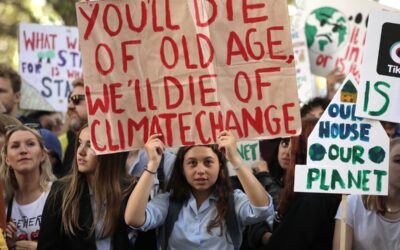Hillary Clinton made a big speech in Iowa yesterday on clean energy and climate change. Here’s the FT coverage, here’s the speech, and here’s the 16 page plan. A few highlights and observations:
First, check out the reframing of climate change as an issue. “For this generation of Americans, climate change is our Space Race. It is our home-front mobilization during World War II and it is our response to the Great Depression.” This kind of language marks a clear break with the more usual discourse of ‘small actions’ as the solution to climate change – energy efficient light bulbs, TVs off rather than on standby and so on – and comes across as more commensurate with the more alarmist narrative about the scale of the problem. (Some obvious influence here from the ‘new Apollo Project’ language that Michael Shellenberger and Ted Nordhaus talk about in their seminal essay The Death of Environmentalism.)
Second, look at the headline emissions target: the US would cut greenhouse gas emissions 80 per cent below 1990 levels by 2050, “the amount necessary to avoid the most dangerous and destructive consequences of climate change”. No bones about it, that is an impressive pledge; for comparison, the UK has pledged a 60 per cent cut in CO2 emissions by 2050 (n.b. that a CO2 target is more demanding than would be the same number for all greenhouse gases; and that Gordon Brown has said he’ll review that figure to see if it needs to be tougher).
Third: an economy-wide cap and trade scheme, with one hundred per cent of permits auctioned (instead of being ‘grandfathered’, i.e. allocated in proportion to existing emissions). And there’s a veritable smorgasbord of other domestic measures as well: an energy efficiency programme to reduce electricity consumption by 20% below projected (and n.b. that word ‘projected’) levels by 2020, a 25% renenwables target for 2030, and Al Gore’s proposed new ‘Connie Mae’ program to “make it easier for low and middle income Americans to buy green homes and invest in green home improvements”.
But here’s the really interesting bit: what she says about the international end of climate policy.
Other countries like China and India, they see we’ve done nothing. They feel free, therefore, to do very little. That is not the way we can lead. We have to prove that moving away from a carbon economy is good for growth and lead the world to a new binding agreement to reduce emissions dramatically.
The President’s failed unilateral energy policy is a part of our failed unilateral foreign policy. It’s deprived us of the credibility and the leverage we need to solve the climate crisis. I’ll change that by leading the process to develop a new treaty to replace the Kyoto Protocol, which is set to expire in 2012.
One of the worst messages the President sent was when he took office and rejected completely Kyoto. He could have said we don’t like Kyoto but we’re immediately starting a new process. But that didn’t happen.
Well, come January 2009, I’m sending a different message. I want to act quickly to help develop a new treaty. I will engage in high level meetings with leaders around the world every three months, if that’s what it takes to hammer out a new agreement. My goal will be to secure a deal by 2010. We can’t wait for two more years.
I will establish an E8 that’s modeled on the G8 which is where the big industrial economies come together. We need the world’s major carbon-emitting nations to come together to tackle these challenges.
The plan document provides a little more detail, hinting (or so it looks) at the possibility of an overall stabilisation target, though probably not a binding one:
Hillary would act quickly in 2009 to restore U.S. leadership in the global warming arena by playing an active role in developing the post-Kyoto treaty. As a guide to the treaty, Hillary would propose a science-based goal to limit global warming to levels needed to avoid the most catastrophic consequences of climate change. She would re-engage in negotiations, work to bring rapidly developing nations like China and India along, and convene high-level meetings every three months with the goal of getting a new deal in place by 2010, two years ahead of Kyoto’s expiration.
Although Edward Luce reports in the FT that “Ms Clinton said she would negotiate mandatory targets that would bind all the world’s polluters – including China and India”, I can’t see an explicit reference to that in the speech or the plan – so it must be derived either by inference from her reference to a “new binding agreement”, or from briefing by her campaign team. (It’d be interesting to know which.) I remain of the view, set out in my recent paper on what happens after Kyoto, that it’s unlikely that any Democrat President could accept a binding target for the US without China and India following suit – but presumably there are limits to how explicit Hillary wants to be about that at this stage.
Usual disclaimers apply, of course, not least that a lot more work will be needed to show how the measures here get the US on track for the very demanding 80 per cent headline target. But the overall impression is that Clinton is serious about the agenda – there’s a lot more here than rhetoric. And it will be interesting to see whether Clinton’s detailed policy platform and wide spread of ‘big ideas’ opens up some political space in Europe for some of the policy interventions that have remained just out of reach for the last decade – especially on energy efficiency.



